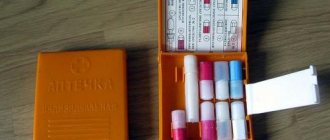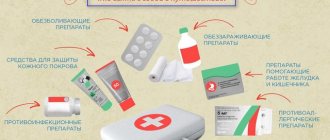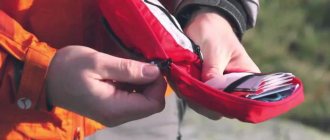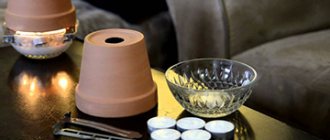Ampoule preparations
Anti-shock kit
Painkillers: 1. TRAMAL – non-narcotic analgesic, anti-inflammatory, antipyretic, has an anti-shock effect. Available in ampoules of 2 ml. It is used for intense pain due to injury, intractable angina, burns, and various types of shock. Used for intramuscular injection 1-2 ml 2-3 times a day. 2. BARALGIN (maxigan, spasgan, spasmalgon) – an anesthetic that has an antispasmodic effect (renal, liver, intestinal colic - relieving spasms). Available in ampoules of 5 ml. It is used intramuscularly 2-3 times a day, or intravenously 3-4 times a day (depending on the intensity of pain). 3. NOVOCAINE (0.5%) – local anesthetic – for local anesthesia. Available in ampoules of 2, 5, 10 ml. Administered orally, subcutaneously, intramuscularly. Indications: angioneuralgia, toothache, burns of the eyes, skin, pharynx, esophagus, trauma, scorpion stings, traumatic shock. Antihistamines, anti-inflammatory drugs: 4. PREDNISOONE (hydrocortisone, dexamethasone) – a hormonal drug that has an anti-inflammatory, anti-allergic effect, and has an anti-shock effect. Available in ampoules of 30 mg (1 ml) RESUNCTION KIT! Indications: bronchial asthma (severe attack), botulism, anaphylactic allergic reaction, allergic edema of the upper respiratory tract (Quincke's edema), collapse (decreased pressure), poisoning, aspiration syndrome, severe intoxication accompanied by impaired liver and kidney activity (hepatorenal failure ), snake bites, scorpion stings. Contraindications: diabetes, severe arterial hypertension. It is used intramuscularly or intravenously at 30 mg. It is administered intravenously in a dilution with saline or glucose. 5. TAVEGIL (suprastin, diphenhydramine, pipolfen) – has antiallergic, sedative, anti-inflammatory, antiemetic effects. Available in 1 mg tablets and 2 ml ampoules containing 2 mg of the drug. Take 1 mg orally (1 tablet) repeatedly. 2 mg is administered intramuscularly. Cardiotropic (cardiovascular) drugs: 6. CORDIAMINE - improves the functions of the cardiovascular system and breathing during shock, asphyxia, poisoning, infection, stimulates the activity of vital centers, increases blood pressure. Available in ampoules of 2 ml. Used intramuscularly and subcutaneously in 2 ml doses. 7. ADRENALINE – RESUSCITATION DRUG – stimulates the cardiovascular system, increases the strength and frequency of heart contractions, increases blood pressure, relieves bronchospasm, is used in cardiac arrest. Available in ampoules of 1 ml of 0.1% solution. Used intravenously at 0.25-1 ml (for cardiac arrest). 8. EUPHYLLIN – a vasodilator, antispasmodic drug, used for bronchial asthma, shortness of breath, cerebrovascular accident, migraines, high blood pressure. Available in ampoules of 1 ml of 24% solution (240 mg). It is administered intramuscularly slowly. Adverse reactions: nausea, vomiting with rapid administration.
This is interesting: Disaster Scenario - Epidemic
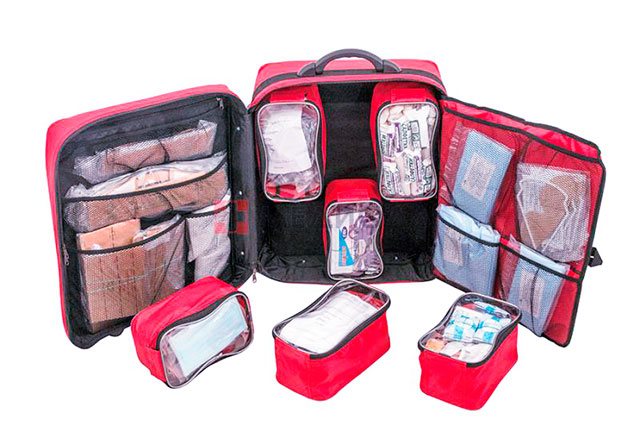
Preparations that have a plasma-substituting effect: 9. POLYGLUCINE (400 ml – bottle) – a solution of dextran that has a plasma-substituting effect. Used for injuries with massive blood loss, shock. Administered intravenously. Diuretics: 10. LASIX (fruzix, furosemide) – used for pulmonary edema, brain edema, and traumatic brain injury. Available in ampoules of 40 mg (2 ml). It is used intravenously or intramuscularly at 20-60 mg.
Sedatives: 11. RELANIUM is a sedative drug from the benzodiazepine group. Used as a sedative and hypnotic antidepressant. Available in ampoules of 10 mg. It is administered intravenously, intramuscularly. Monitoring the state of external respiration is necessary! Serums, toxoids: 12. TETANUS ANATOXIN – a prophylactic agent for infected wounds. See instruction insert.
Antibacterial drugs: 13 GENTAMICIN is an antibacterial agent, used for infectious diseases, wounds, injuries, and is a means of combating severe purulent infection. It is administered intramuscularly 2 times a day, 40-80 mg (depending on weight).
World after the end of the world
didn't go too far. Because hiking and migration are extremely different things. The hike is clearly limited in time, route, and goals. When a person puts a camera and ten of his favorite knives into the EDS, I understand that this is a mattress pad who is going on a mattress hike to have fun. Although of course he still has more chances, that’s why I approve, even though he doesn’t give a damn :). No one takes things of value, including personal value, on a hike. Like a couple of kilograms of documents accumulated over a lifetime, including property rights, or everything there is of jewelry, including keys to a garage, car, dacha, and other crap for half a kilo of keys alone. or photographs, about twenty of them, which will soon become your most valuable belongings. Or when you pick out batteries even from remote controls. And so on. I would look at a person who is going to throw everything away and leave with a pair of panties and socks. Because 7 days are designed to ensure that you will most likely never come back. And if you return, bare walls will be waiting for you there, if you’re lucky. And you will have to explain what the hell you forgot and are doing here. Preferably documented. Without a piece of paper you are a turd, but with a piece of paper you are a person. Because of this, you will be carrying a lot of things that you don’t take on a hike. This is not a hike. Only children can say that this is a hike, so there would be less panic and fewer dolls. But you can tell your daughter: “We’re throwing all her plastic and real girlfriends in the face”...... It’s mandatory to take clothes. Panties and socks are consumables; you will not wash them. Just throw it away and wear clean ones. And so on. So, either a large backpack, and a small 30 liters liter for jewelry, documents, and the most necessary things, and a kravchuchka trunk (you can read my topic) 80-100 liters. I prefer the second option. as the most practical. Especially if you have a couple of usable carbines and tape.
In general, a survivalist is an ephemeral concept. Akin to a club of interests, divorced from reality. This is useful primarily because a person thinks about all this, how he will act if what is considered ordinary and normal disappears around him, at least for a while. A negative forecast is taken as probable and possible, and then options for the best are developed. But in Africa a knife is a knife, and a pen is a pen. If only I could write. You can call it tactical at least 100 times, and call the knife a chewing knife - this is mostly marketing. Because a luminous pen is crap in the cold. And the usual plywood forend of a hunting AK is better and lighter than any aluminum body kit, although it doesn’t look cool. It’s better, if only because your hands don’t freeze to it, and when you release 6-7 magazines, it’s barely warm, and doesn’t tend to fry your fingers. In short, the only thing you should worry about is how to carry the maximum weight over the maximum distance in the minimum time on your own two feet. That's all. Because your daughter will be pulling her favorite doll, your wife will be carrying gaskets, and you will be carrying a bag of waste paper from diplomas, bills of sale, keys, photos, and other crap, a total of at least 5 kilograms, and in volume just 30 liters. And that’s the minimum. And it is right. After all, you need to be prepared for the scenario when it is not in vain and everything is needed. At least for wiping and kindling. This will make it easier for you to take a step out the door, as well as for your family. and then “the war plan will show”
When to use an army first aid kit
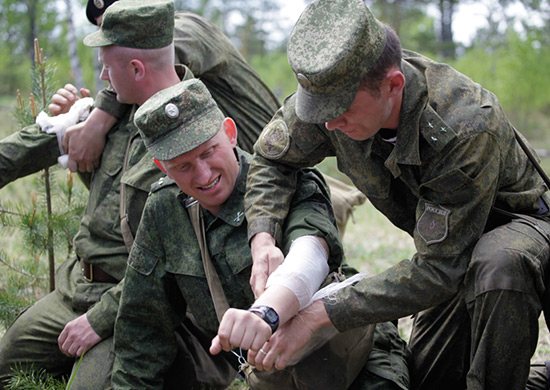
The following medications are used independently if indicated:
- remedy for FOV poisoning - at the first signs of damage;
- analgesic - for injuries and burns accompanied by severe pain;
- antibacterial agent - for wounds and burns;
- antiemetic - for nausea caused by exposure to ionizing radiation, as well as contusions and other factors.
Only upon command (instruction) of the commander is used:
- radioprotective agent;
- antibacterial agent - in case of danger of infection by pathogens of infectious diseases;
- prophylactic against poisoning FOV (tablets) - in anticipation of the sudden use of chemical weapons by the enemy;
- antiemetic - in anticipation of exposure to radiation in large doses.
- The prescribed dosages of medications must be strictly observed to avoid a decrease in their effectiveness or negative effects on the body. For this purpose, first aid kits contain syringe tubes.
Existing types of army first aid kit
Honey. the substances in the personal first aid kit are intended for first aid. They are intended to relieve pain in case of burns and wounds, and provide prevention of wound infection. It also contains individual means for disinfecting water, washing eyes, for headaches, and to stop bleeding. With its help you can save the life of a fellow soldier or a civilian.
Individual
A modern individual first aid kit is called AI-4 - a means for providing assistance in the event of a weapon of mass destruction and injury. The first aid kit was developed to replace outdated products with prohibited drugs (for example, AI-2). It is intended to provide first aid in the form of self- and mutual aid, to prevent or weaken the damaging effects of radioactive substances, bacterial agents, and organophosphorus substances.
Military first aid kit
The AB first aid kit is designed to equip combat vehicles and military equipment on wheels and tracks. Designed to provide first aid in the form of self- and mutual aid to 3-4 wounded and burned members of the crews (crews) of combat vehicles and military equipment.
- antiseptic (iodine 5% alcohol solution, 1 ml);
- irritant (ammonia 10% solution, 1 ml);
- water disinfectant (“Pantocide” in the table, 0.0082 each);
- dressings (sterile gauze bandage, small medical bandages, medical scarf);
- hemostatic tourniquet;
- the pins are safe.
The weight of a military first aid kit is 800 grams.
Individual anti-chemical package
Individual anti-chemical packages IPP-8, IPP-9, IPP-10 have not been produced by our industry for more than 10 years. They were replaced by the IPP-11 package. However, the units still have large stocks of previously produced individual anti-chemical packages, which can and will be used if necessary. Individual anti-chemical packages are designed for disinfection of droplet-liquid chemical agents and some chemical agents that have come into contact with the human body and clothing, personal protective equipment and weapons.
IPP-11 is intended for the prevention of skin blister lesions with highly toxic (insecticides, pesticides) and poisonous substances through open areas of the skin, as well as for degassing of these substances on the skin in the temperature range from -20 to +50 degrees Celsius. When applied to the skin in advance, the protective effect of PPI-11 lasts for 24 hours.
The product IPP-11 has a degassing ability in relation to all familiar poisonous drugs with blister effects; however, it does not irritate the skin, but, on the contrary, relieves irritation and pain of the skin.
PPI-11 is effective when treating skin around wounds and is safe if the product comes into contact with wounds . The product is chemically neutral in relation to any construction materials and fabrics. The IPP-11 formulation is a liniment of salts of rare earth elements in polyoxyglycols.
IPP-11 is a sealed bag containing a non-woven tampon impregnated with the product. Package weight - about 35 g. Dimensions - 90x130x8 mm. Each military member is recommended to carry four bags. IPP-11 has no analogues abroad in its composition and properties.
A minimum set of medications, or a survivalist's emergency first aid kit
Few people have the desire to stock up on tablets and tablets in advance, especially since pharmacies have settled on every corner. But have you ever thought that in response to symptoms we receive drugs exclusively in colorful and bright packaging? Nothing personal: pharmacist and
I am a tough business with low profits.
Vadim Prelovsky, a student at the School of Trouble Shooters, and I have compiled instructions for those who are mobile and independent. Be prepared to distinguish international nonproprietary names from trade names:
1. Allergies
will eliminate:
- for skin irritations - light antihistamine gels “Fenistil”, “Psilo-balm”
- for inflammation and severe itching - hormonal ointments "Akriderm", "Comfoderm"
- Dexamethasone ampoule will ease reactions to exotic foods and insect bites
- Desloratadine (Aerius) and fexofenadine (Fexadine) will not cause drowsiness.
2. Cuts, abrasions and wounds
will help:
- healing panthenol in the form of a spray: cover the sores with a thin layer without using your hands
- antibacterial ointment levomekol will overcome purulent lesions and burns
- Wash large problems with chlorhexidine
- antimicrobial powder “Baneocin” is convenient due to its small size and ease of use in the form of an ointment; budget option - streptocide sachets
- the unfamiliar compact hydroperite (“solid peroxide”) will calm the bleeding and remove dirt from the wound with oxygen bubbles.
3. Sore throat
will please:
- furatsilin, diluted in half a glass of hot water; if possible, choose effervescent: save time on dissolution
- powerful “Septolete Total” and “Grammidin neo with anesthetic” for resorption
4. Inflammation of the eyes and ears
They treat with drops "Okomistin" and ofloxacin ("Dancil") from the category "both the Swedes and the Reapers."
5. Plasters
needed at any time of the year, not for you - so for the lady and the child:
- dry callus "Salipod" will soften the skin, eliminating rough and old formations
- sterile "Cosmopor" - does not stick to the affected area
- bactericidal - a lot: assorted sets of various shapes, sizes and materials; make sure you have waterproof ones
- hydrogel ones work like a “second skin”: they will prevent you from limping due to a burst callus, and will protect you from pollution for a long time
- coils: fabric - securely fixed, paper - light and pleasant to the body, silk - do not cause irritation.
6. Must-have for travelers
- loperamide (Imodium) will stop severe
diarrhea.
And nifuroxazide (“Enterofuril”), unlike the previous drug, does not “lock” the intestines and destroys bacteria - the main source of poisoning, helping to recover much faster.
7. Condition after intoxication
will improve:
- “activated carbon on steroids” “Filtrum” - does not require dilution
- "Regidron" or "Trihydrosol" will replenish electrolytes after vomiting.
8. From parasites
Albendazole (“Nemozol”) will save: removes roundworms, pinworms, tapeworms.
9. For pneumonia
and infections of soft tissues, a broad-spectrum antibiotic, azithromycin, is rational.
10.
Severe influenza conditions
will be alleviated by the antiviral oseltamivir (Tamiflu).
11. Cold symptoms:
fever, pain, runny nose are leveled by Rinza or Rinicolda tablets.
12. Nasal congestion
They will remove drops for children: they will help, despite the concentration, plus the risk of addiction is several times lower. “Nazol Baby” is good.
13.
Ascorbic acid in your backpack will calm those who fear
scurvy
. For drinks, use a sachet per liter of water or an effervescent tablet per glass.
14. Pain will be quenched
analgesics - taken only during or after meals:
- "Pentalgin" - advantageous in its combined composition, also acts as an antispasmodic
- ibuprofen (“Nurofen”) - for mild pain causing moderate discomfort
- ketorolac (“Ketanov”) - exclusively for injuries.
15. Unexpected pressure surges
captopril (high) and caffeine-sodium benzoate (low) calm.
Other utilities in the field:
- Look for an elastic bandage that is cohesive (self-fixing): lightweight, holds without clips or Velcro.
- Good old Vaseline won't hurt. Take it in a glass jar: it won’t crumple or leak.
- Crush the “Snowball” bag, activating a cold compress for bruises, overheating, or heat.
- Grab an alcohol-containing solution: treat your hands, the injection area, light a fire.
- A pill box, in addition to pills, will help keep matches and small items dry.
- Vaseline oil is an excellent lubricant for knives and other tools.
- Hemostatic sponge is a miracle remedy for stopping bleeding.
- Cotton wool compacts things and serves as kindling material.
- A condom, in addition to its main purpose, can help carry water (put a sock over it to avoid damage) or protect the wound from getting wet (cut out the tip and pull it over the limb)
- Multifunctional bottle of potassium permanganate (potassium permanganate):
Tips for putting together a kit:
- Make friends with the pharmacy chief: he will advise you in response to courtesy and friendliness.
- Replenish your supplies by listening to knowledgeable experts justify your choices.
- When traveling with your significant other or child, take into account their characteristics.
- Do not listen to grandmothers and neighbors if they are not doctors or experienced hikers.
- Consult your doctor to rule out possible harmful effects.
- Check expiration dates and storage conditions regularly. Ointments are often kept in a cool place, and drops rarely “live” longer than a month after opening.
- Do not neglect the instructions: study the dosage and frequency of use, interactions with food and alcohol.
- Look for pharmacies that, in addition to the “originals,” offer affordable alternatives—generics without rolling your eyes.
- Pack medications carefully so as not to collect wet coins and broken ampoules.
- And most importantly: don’t focus on pharmaceuticals - focus on prevention!
What is a survivalist backpack?
This is a voluminous shoulder bag, the contents of which are enough for the autonomous existence of 1 person for several days. This feature makes it similar to an alarm suitcase. However, the latter is much more compact and is designed for only 1.5-3 days. Well, a properly assembled survival backpack can ideally help you survive for a whole week . If it is possible to replenish food supplies - 2-3 weeks.
Important! A real survivalist's backpack weighs about 20 kg - an unbearable burden for many people. They won’t be able to go far with it; they’ll have to quickly part with important things along the way. To prevent this from happening, it makes sense to initially pack a bag for 3 days, not 7.
